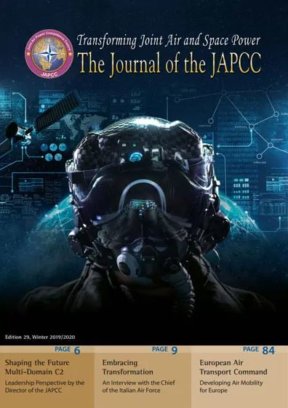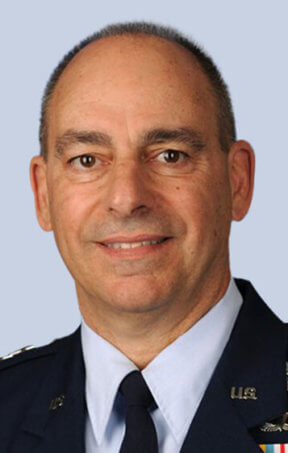In the seven months since I took command of Allied Air Command, I have had the opportunity to travel across the European continent to see Air Power at work. I have seen tremendous work done by the outstanding men and women of our Alliance Air Forces, both within Europe and North America, and beyond. The efforts made every day to deter potential aggressors and provide increased stability along NATO’s borders left me both humbled and proud to be a part of your team.
Allied Air and Space Power is entering a new era of increased speed and digitization. The systems we develop and operate to secure, defend and control the Air domain are more reliant on Cyber and Space-based capabilities than ever before. They enable us to connect, make decisions, and respond at speed to a spectrum of evolving threats from high-end peer competitors to Violent Extremist Organisations (VEO). However, as our capabilities evolve, so does the threat we may face in the future. We must maintain momentum. We need to continue to improve our Joint Command and Control systems and fully network them across the Air, Land, Maritime, Cyber, and Space domains. Multi-Domain Operations and relevant Command and Control (MDO/MDC2) will shape our future. We must now take steps to maintain our advantage and initiative.
The challenge is to move from today’s operations across all domains to tomorrow’s Multi-Domain Operations. MDO was the theme of our annual Joint Air and Space Power conference held by the JAPCC this fall. As the Director of JAPCC, I want to open this 29th edition of our Journal with my thoughts on the outcomes of this conference and the three elements of MDO: Connecting, Decision Making and Responding at Speed.
The return of inter-state strategic competition is shifting our modern warfighting approach. Technologies associated with adversary threats continue to evolve. Advancements exist not only in traditional kinetic weapons like hypersonic missiles, but also in non-kinetic capabilities. Weapons now manoeuvre in and through cyberspace and are able to generate terrestrial effects from space. By recognizing the complexity of our operating environment and leveraging technological advances, we ensure that we stay at least one-step ahead of our adversaries across our full range of capabilities. The ability to present multiple and simultaneous dilemmas to our adversaries will overload their capacity to react and allow us to maintain the initiative.
It all starts with connectivity through a fully networked force. Sensors exists across every domain, but connecting those sensors remains challenging. As we think about existing and developing sensors, we must connect them to form a cohesive, resilient and self-healing collective network. Therefore, it is crucial that we build in multi-domain interoperability from early design with any future capabilities.
We have also made great progress in the field of datalinks that enable us to disseminate and exchange information across domains and services, but significant work remains. Earlier this year, Link 16 became the NATO Minimum Military Requirement. The sharing of information through datalinks will heavily augment situational awareness in future conflicts. As one of our NATO Air Chiefs stated during the JAPCC conference, victory will depend on the strength of our interconnected networks. As datalink capabilities continue to become ‘standard’ across our forces, we must challenge ourselves to use them in daily training. Persistent datalink use will set the foundation for follow-on networked solutions. We cannot rely only on what we have today. Rather, we must strive to have state-of-the-art datalink networks in the future that will enable 5th generation systems, improve sensor fusion and allow us to harness big data.
However, network connectivity is only the first step. We have to ensure we fuse the information collected by our network of sensors in ways that facilitate rapid sharing. This agility will lead to faster decision-making, eventually pairing the appropriate effect (whether kinetic or non-kinetic) with the right target. We must do this through agile software development that leverages Artificial Intelligence and automation. To make this happen we need to develop capabilities fast, and I mean in the next couple of years, as waiting for 2040 is too late. We need to embrace our industry partners and have an incremental and modular approach. We must develop new tools faster than our traditional military processes permit, in order to sustain the speed of relevance. Tomorrow’s joint leaders need to understand all domains sufficiently to be able to optimize the capabilities we develop and bring them to bear in the most effective and efficient manner. This will include transitioning from humans ‘in-the-loop’ to humans ‘on-the-loop’. Tomorrow’s leaders have to maximize emerging technologies while managing operational risks and the moral and ethical challenges of automation.
Connected networks, informed decision-making and the ability to respond at speed are all critical capabilities as we seek to leverage existing and emerging technologies in support of NATO Air & Space Power. I am excited to explore new possibilities and technologies with the knowledge that this exploration will occasionally mean failing … and that has to be okay. I offer to you that the importance of continuing to challenge our assumptions is instrumental to our ability to maintain momentum. We must always foster a culture of innovation. We need to listen to our younger contributors, the junior officers and enlisted men and women closest to the fight. They are going to bring forward the great ideas that we, senior leaders, cannot afford to ignore if we want to remain relevant.
We must evolve our alliance into the connected, Multi-Domain fighting force that future conflicts require. We need to be agile and act at the necessary speed to maintain our advantage and our freedom of action. I have great confidence that amongst our nations and partners, people are going to figure out the best way forward. It is not going to be easy. I look forward to working with you to bring these future possibilities into operational reality, with the requisite training and exercises to enable mission success.
Finally yet very importantly, I would like to recognize that the challenges mentioned above are less daunting because of the quality of people serving in both the NATO Command Structure and the supporting organizations like the JAPCC and other COEs. The personnel investment in these organizations yields fantastic synergy. This helps us transform NATO Air and Space capabilities into the future force we need to ensure we continue to deter our adversaries and defend NATO’s territory. Keep up the great work and let’s get after it!












